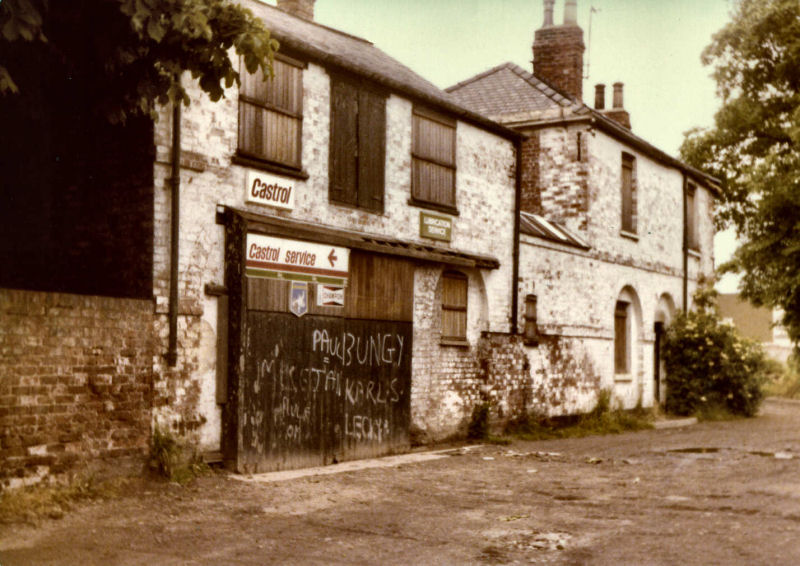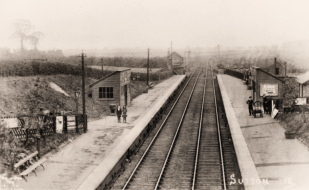
S U T T O N & W A W N E M U S E U M
|
Y O U R
M E M O R I E S brought in or emailed by our visitors ~ plus other miscellaneous items of local interest ~ |
|
|
FORMER PUPIL VISITS
OLD SCHOOL Both Merrill and Liz
were on hand to consult the card
index and find the right albums, and
Neil and his wife were delighted to
rediscover so many faces and
memories of former years. Neil is
here, in this first photo, top left,
standing at the back looking rather
thoughtful, and tells us that he
remembers these photographic
portraiture sessions well, as all
the class were involved and many
shots involved several 'takes'. And
early introduction to the dark arts
of photography. Mr Johnson used to
develop his own photos, and so these
sessions were indeed multi-lessons
in themselves, encompassing several
mainstream subjects. First, but not
least of course, is art, with
smidgeons of history and science
thrown in. The science coming via
the understanding of the chemicals
involved in the developing process,
as well as physics in undertanding
optics and how the camera lens works
in much the same way as our eyes. A pretty fair grasp of English reading skills would be required if a pupil wished to delve any further to improve his skills and consult the many textbooks on the subject at that time. |
And finally, I daresay (not being a photographer myself) that a good understanding of basic maths would also be required, if only to understand apperture settings, the principles of light exposure and the zoom lens, let alone the sizing and cutting of the final product. A good all rounder, was photography. There
are still a couple of tempter
samples of Mr Johnson's photos
below, but most of them have now
been moved over to our new
Photo Galleries Page and then choose Gallery 3, where you can see many more.   |
|
SLIDE
SHOW
This is the third test in a project to see if we can display a successful slide show with minimum coding. This selection of photos were taken by ALAN THURLOE, one of our volunteers and an old pupil of St James' CofE School in Sutton. This show may not always appear in this position here, we may put future ones on a separate page, or in a more prominent position. It's still just testing to see if most viewers can see it on most browsers. Move your mouse to one side out of the way; A short description should appear with each slide and the control fade out. A SELECTION OF ALAN'S SCENES : "THE VIEW FROM THE TOP" |
A recent email
from Andrew Suddaby, a
Sutton ex-pat now living in
Cumbria, explains his
understanding of the origins
of our 'Humber Stones',
situated at the gates to the
War Memorial. Additionally,
a personal biography of his
family was deposted some
years ago with our museum,
and can be seen in our
collection on Fridays. He
also asks if anyone knows
the whereabouts of an old
Sutton Scouts trophy.
F/Lt
Paterson Clarence Hughes
DFC RAAF
Other visitors
were a family from Surrey.
Howard, Vanessa, Jack, Lara,
and Charlie Paterson Hughes,
came to visit our brave
pilot's grave in the
churchyard. MORE BLASTS FROM
THE PAST We've
had a wonderful offer from
Margaret Rowling (nee
Bruce), seen below, who grew
up in Sutton in the
1950's-60's. Margaret, a
retired teacher, now lives
in Filey, and she has
offered to our collection
her own slides of Sutton
from those years. The
late Terry King sent me a
clipping, some years ago,
he'd saved from the Daily
Mail, an article by a staff
writer editing reader's
memories. At a guess, it
dates from some time in the
1970's or 1980's, and I
would imagine a lot of folks
mentioned in this lady's
memories are no longer with
us. The subject lady
herself, Barbara Rowntree,
eventually became Barbara
McGough, and after
travelling and working all
over the globe in a career
editing various magazines,
she emigrated to Adelaide in
South Australia. She had
seen an aerial view of
modern Sutton, and it had
prompted her to write to the
HDM with her own memories of
the places she could still
locate on the photo. I
thought the whole article
worth seeing, and so have
reproduced it here in its
entirety - Enjoy ! SUTTON
MEMORIES How deep
childhood impressions go ! My
recent memory is a very
fallible sign, I think, not
only of old age, but of the
increasing complexities of
life; but my early
recollections are still
startlingly vivid. It has been
dated to 1962, by ex-resident
Elaine Durrant (now Carney)
who has lived in Gueph,
Ontario, Canada, since 1966.
Elaine identifies the players
thus: John Kemp in
the USA (on photo, front row )
sent this photo via his friend
(and our previous
correspondent, the late Terry
King). Amazing how these
memories travel the world
through cyberspace to arrive
back here. It's a photo of
Sutton AFC Amateur League, Div
4, 1951/52 Season, when they
won the League in that year.
They're all Sutton Lads, and
Terry's own father is on the
right. Names are : Back Row
left to right .. Tom Jones, J
Buxton, Mr Rust, Les Buxton,
Frank Atkin, Colin Duncan, Ian
Singleton, Harold King. Middle
Row ; Alan Rooke, Johhny Read,
Geof Hall, Eric Harrison, Alan
Constable. Front Row ; Alan
Jones, John Kemp Terry King, also
sent this old photo a year or
so ago dating from the early
part of the last century.
Taken about 1914 or just
before the First World War,
Terry's mother, born 1906 and
aged about 6 here, is on the
second row from the front,
second in from the left.
Another sister is at the other
end of the row. Their maiden
name was Catterick. Old images
such as this are so full of
atmosphere. Look at those lads
standing proudly with their
arms manfully folded. Many
would have fathers soon to be
lost in the First War, and
whom themselves in turn would
go on to have, and lose, sons
that would know the terrors of
fighting in the Second. And
the girls, of course, as wives
and mothers, by and large kept
house and home together while
they were away . . as did
Terry's mum shown here. She
later knew the trauma of the
Blitz, and of having her son
evacuated to the Lake District
and not knowing how it would
all end. Can anyone recall the
name of the school mistress ?
A familiar site
in Sutton in the 1950's,
before Bransholme was started,
when the 32 service terminated
in Church Street. Behind this
AEC Regent III, note the
Corporation Telephones
phonebox which used to be just
at the end of the church wall,
right opposite College Street.
This picture is
an improved copy of one
formerly supplied by the late
Terry King of Sutton. We know
now that it is copyrighted to
the Lens of Sutton Association
and the Ken Hoole Study Centre
Collection at the Darlington
Railway Centre and Museum. It
was supplied to us by the good
offices of Ken Mell, former
Sutton resident and St James'
school pupil, and enthusiastic
railway photograper. A
slightly foggy but very
atmospheric day on the Hornsea
line, as two young girls
appear to be awaiting the
train to the seaside, though
more probably to school
somewhere. Note the signal
box, where the playground is
now, and the points for the
coal siding. You can click
this picture for a greatly
improved image.
Stories and photos
contributed by viewers and
ex-residents
![]()
![]()
SOME
OTHER RECENT EVENTS
Andrew writes: "I didn't
know that the large flat
stone was called the 'Humber
Stone' but I have a very
distinct memory that, when I
was a young boy in the late
1940s or very early 1950s,
an old villager, but I
forget who it was, told me
that the larger flat stone
in front of the war memorial
had originally been sited on
the low lying ground roughly
where the old coal staves
were (now by the cycle path
as it leads into the
childrens' playground area).
He added that it had stood
at the edge of the 'lake'
and had acted as a 'landing
stone' way back in the days
(possibly medieval but
probably much earlier) when
that area to the North of
the village was under water
and was a fishing ground for
the villagers. I suspect
that it was brought up to
its present position when
the war memorial was
erected."
"I lived down Highfield and,
as children, we often played
in the field that is now
covered by Highfield Close.
Locally, the field was
called Beckett's field
because Mr Beckett, the coal
man, grazed his horse there.
It was actually owned by the
Sewell family who had built
the houses down Highfield
and originally intended to
develop this field. The
entrance off Highfield had
been started in pre-war days
but development of Highfield
Close was delayed by the war
and didn't get under way
until some time in, I
believe, the 1960s. Very
pronounced Medieval ridges
and furrows stretched all
the way down the slope of
the field from up near the
big house, which during and
after the war was used, I
recall, as an auxiliary fire
headquarters. That field
must have been one of the
last surviving bits of the
old Medieval field system. A
tree that we loved to climb
still stands in the front
garden of one of the houses
but the lower branches are
now too high off the ground
for small children - or even
adults - to reach!
Incidentally, does anyone
know the whereabouts of the
1st Sutton-on-Hull Scout
Troop trophy? This was the
tip of the wooden propeller
from Amy Johnson's plane. I
don't think that it bore an
inscription to that effect
but it was made of mahogany
and stood about ten inches
high on a wooden plinth. I
suspect that it was dumped
years ago but, if anyone
knows where it is, it would
be an interesting addition
to your collection."
Andrew mentions another
memory that may well gell
with some readers: Who
remembers the Scout meetings
in the Church hall that
always ended up with games
of British Bulldog (a wonder
we didn't maim each other)
or shuffle bottom kick ball.
That floor got a regular
Tuesday night polishing off
our corduroy shorts and they
in turn got a very shiny
coating on them! God knows
what our mothers made of it
all!
Indeed!
Andrew was born at 23
Highfield in 1938, and
evacuated after the land
mine dropped lower down
Highfield causing massive
damage to all the houses
down there including number
23. They spent the remainder
of the war in the village of
Rawcliffe near Goole and
returned in December 1945
after his father was
demobilised from the R.A.F.
Past visitors to the
museum were Ray and Pat Kirby,
now living over in Derbyshire.
Older residents will perhaps
recall Ray as the son of Doris
Kirby, and who left Sutton to
persue a teaching career in
various parts of the country,
including the London and
Manchester areas. Ray later
became a school head, after
many years teaching history.
They both enjoyed their visit,
browsing the many albums and
recognising the many old faces
of relatives, school friends
and neighbours. An accolade
indeed from a history teacher,
we think we got a definite
'thumbs up' from them both,
and we look forward to seeing
them again when they're next
over this way.


It's lovely to know that other
folk care, and remember. That
is some gorgeous bunch of
flowers, for a man who lost
his life on behalf of our
country and freedom 73 years
ago this coming September.
I hope the family don't mind
us calling Pat 'our pilot'. Of
all the wargraves in our
churchyard, Pat came from the
furthest away, he was so far
from home. I suppose we have
sort of adopted this quiet
mannered Australian who would
never live to see the part he
played in our freedoms today.
If this family would like to
contact me, a better copy of
this photo awaits them, plus a
short piece of small video of
the grave and the church in
the background. I'm sorry we
missed them; a day later, and
they would have found the
museum on its normal Friday
opening. We would love to have
met them. I do wonder if they
have seen Pat's page on this
website, and the story of how
it came about; perhaps that's
how they found us here in the
first place. Click Pat's name
in the underlined link above.

She
first wrote a
couple of years ago to send
us the photo of Church St in
the snow shown on the Home
Page, and now she has
written to offer us the
slides, and also to give us
the link to her collection
of photos she has posted on
her Picasa Web Album online.
Click HERE . .
and then select the set you'd
like to view. Quite a few old
Sutton memories on here, of
Garden Parties and other
events. There's some others
too, on Filey, and history,
and gardening. Enjoy !
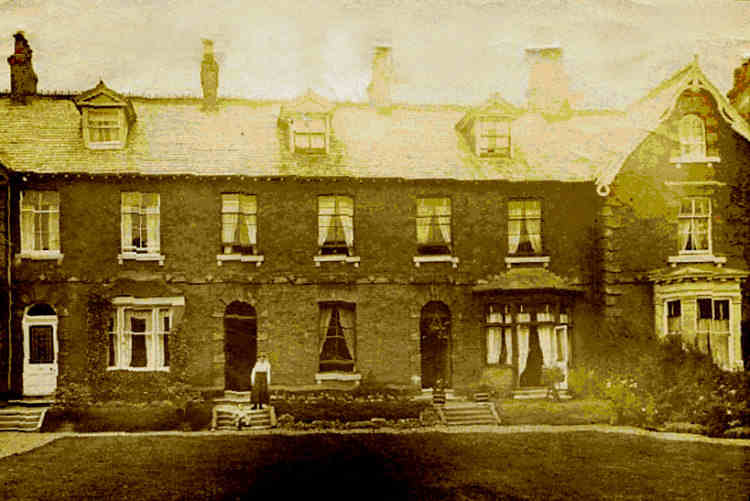
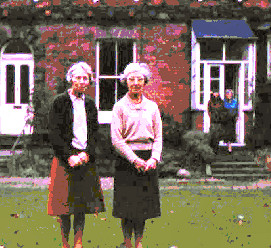
So it is with my opposite
number in Adelaide, South
Australia, Mrs B L McGough,
formerly Beryl Rowntree and
now professionally known as
"Barbara Page", the 'Miss
Humber', it would seem, of
their evening newspaper, 'The
News'.
Mrs McGough, who is also doing
a lot of freelance work for
mainstream magazines and
radio, was born in Sutton, and
she was extremely interested
in one of our aerial
photographs of that area which
someone sent me during the
summer.
"Seeing the photograph has
brought back a flood of
memories," she writes. "The
place hasn't altered greatly
in its layout; I can recognise
every stick and stone.
"I can see the house where I
was born, 2, Rutland Terrace,
with my grandparents' house
next door. Mr and Mrs W
Goodin, they're buried in the
churchyard there, with the
names of my two brothers
inscribed on their gravestone,
Cadet Kenneth W Rowntree, aged
16, lost at sea, and
Pilot-Officer H Raymond
Rowntree, aged 21, lost on
operations, both in 1941.
Mrs McGough remembers the
names of many people who lived
in her street.; The Pinkneys,
The Danbys, the Hakeneys, the
Simpsons, the Pitchers, the
Grays, the Hodgsons.
"Church Street was the hub of
our universe. I remember the
Carricks at the corner of
Stoneferry Lane, the station
where I watched troops going
off in World War I, the church
school, the church where we
played many hours happily
among the graves, the
Methodist Chapel where I went
three times every Sunday.
"I ran my mother's messages
there, shopping at
Wheelhouse's, spending my
Saturday pennies at Rene
Rodmell's sweetshop, buying a
reel of cotton at Miss
Heron's, the drapers (and I
can still hear the tinkle of
the bell on the shop door as
you opened it).
"We gazed at the mugs and jugs
and bowls in Miss Moody's and
stopped to look at the pots
and pans in Fletcher's.
"Every day I walked the long
stretch to the Council School
up on the hill four times a
day. I can even remember my
first teacher there, Miss
Richardson, beating time to
'All Things right And
Beautiful', apparently her
favourite hymn.
"I can still pinpoint Holmes
the butchers, and Hickeys
further along. Sutton House
has come out fine; I remember
picnics and garden parties
there and the annual Horse
Show.
"Winnie Leake lived in a house
on the estate, and learnt
music with my teacher, Bertha.
The Sewells lived just there,
opposite Potterill Lane, and
their nieces, Marjorie and
Mary Cross - I went to their
double wedding in the
Methodist Chapel in 1938 or
1939, and watched them given
away by their aunts, Lydia and
Hetty."
Mrs McGough adds that one of
her schoolteachers, Clarice
Annison, is still living in
Church Mount. An uncle, Mr
Harry Goodin, is still living
in Sutton, and until recently
another uncle lived in Lime
Tree Avenue.
She draws a vivid picture of
life in pre-war Sutton, when
the church bells rang … and
later, one would meet the
bellringers, a solid and
portly group, in best suits
and boots, watch chains and
waistcoats.
"Having rung the bells, they
never felt obliged to attend
the formal services and took
their regular Sunday morning
stroll always in the same
direction. I know this well,
because my Uncle Tom was one
of the bellringers.
"We had the 'gentry' then …
the Smiths, the Robsons, the
Waterhouses, the Bladons, and
the differences were sharply
defined. But somehow we never
felt deprived or inferior. We
all knew our places.
"The doctor had a special
place too, and everybody in
the village knew Dr Gillespie
and looked up to him in a way.
And then he took on a raw,
young partner, Dr Bruce. I
well remember the curiosity
about the new, pink-cheeked
Scot, who, my grandmother
said, was 'too young' and she
much preferred old Dr Shaw who
visited the village every so
often …"
Since
leaving Sutton at the age of
20, Mrs McGough seems to
have had many adventures. In
1943, she went to Dublin
with her Irish husband, and
from 1947 to 1955 was editor
of the Irish magazine,
'Woman's Life', later
incorporated into 'Women's
Realm.'
From 1956 to 1965 she was
Woman Editor of the Dublin
Evening Herald, when she
left to travel the world,
ending in South America in
1970, from where she went to
London to become Travel
Editor for 'She.'
Mrs McGough later went to
Australia to live with her
daughter, hence her
semi-retirement doing
freelancing work on the
Adelaide newspaper. That was
several years ago, and she
would be well into her 80's
now if she's still alive.
I'm sure her memories are
shared by many other folks
too, and do illustrate what
a close-knit community
Sutton was in those days.
from 10 am to 2 pm . . .
soft drinks, tea, coffee,
biscuits can be served ..
£1 per pot of tea or
coffee
Not bad for a drink, a
biccy, and a natter!
GO
TO NAVIGATION BUTTONS
ABOVE
SOME
PICS OF SUTTON MEMORIES
What about the folks in this
modern photo ...?
Any memories of this band when
they played
Sutton Church Hall ... around
1959-60 ...
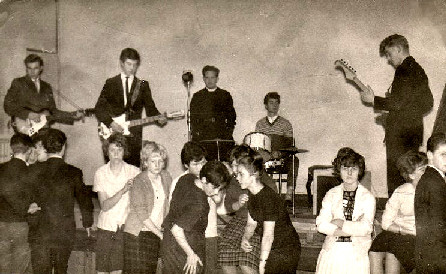 "The photo of
the rock group - This was the
Aztecs, playing at the Sunday
evening youth group in the
church hall, in 1962 I
believe. The lead guitarist ,
second from the left, was
Douglas (Bugs) Scarfe (who now
lives in Italy). The drummer
was not from Sutton. I believe
his name was Charlie and he
went on to be a professional
drummer. At the back is the
Vicar, Rev. Richardson. At the
right, playing rhythm guitar
is Brian Holland. He lived on
Tweendykes Road, unfortunately
has now died. The singer was
the son of the church organist
and he was Grahamme Bateman. I
recognize the Blain twins
dancing." Thank you, Elaine.
"The photo of
the rock group - This was the
Aztecs, playing at the Sunday
evening youth group in the
church hall, in 1962 I
believe. The lead guitarist ,
second from the left, was
Douglas (Bugs) Scarfe (who now
lives in Italy). The drummer
was not from Sutton. I believe
his name was Charlie and he
went on to be a professional
drummer. At the back is the
Vicar, Rev. Richardson. At the
right, playing rhythm guitar
is Brian Holland. He lived on
Tweendykes Road, unfortunately
has now died. The singer was
the son of the church organist
and he was Grahamme Bateman. I
recognize the Blain twins
dancing." Thank you, Elaine.
... and who recalls
this Soccer Team, c. 1952
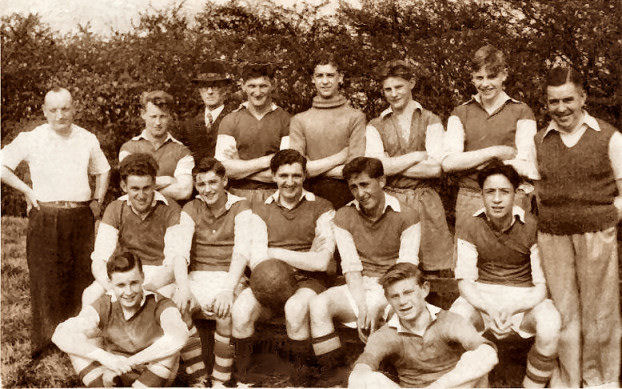 Happier
and Carefree Days
Happier
and Carefree Days
A FAR OFF IMAGE OF
THE OLD SCHOOL AND PROUD DAYS
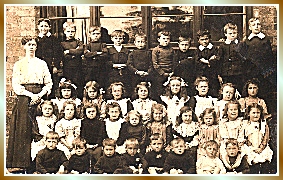
There is more information
on the Hull Blitz here ..
Maps of Hull
showing the fall of bombs
during the Blitz
... in reality, 16 scans, A4
size, of a larger streetmap of
Hull, dated 1945. It tells it's
own story, and is some testament
to the some 1,300 Hull residents
killed, listed above in the
Civilian Index, and the 12,000
injured, during those dark days.
Opens in a new Window.
TWO SIGNS OF THE
CORPORATION . .
another of Terry King's pictures
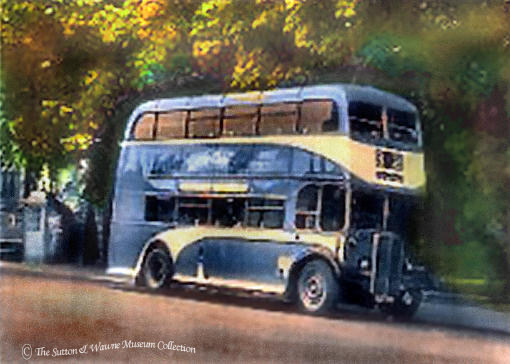
Behind the cameraman would
have been Brown's Fish &
Chip shop, formerly owned by
the Sykes family, and the Duke
of York pub. The Duke is still
there, but the chip shop is
now a foreign 'takeaway'. Such
curious terminoloy they use
now, our fish & chip shops
were all 'takeaways' but we
didn't seem to have the need
to spell it out. We just knew
what was what.
I love the story of the family
that lived just about opposite
the railway station, in the
days before the trees grew so
large. When getting ready for
work in a morning, the gent of
the family could look right
out over to Swine, and see the
smoke of his morning train
into Hull as it left Swine
station. He then had plenty of
time to finish his coffee, don
his hat and coat, and walk the
few hundred feet down the ramp
to the station. Except, on the
very first morning of diesel
operation; there was no smoke
. . . so naturally, he missed
it. I'm told his name was Mr
Cross. And I bet he was too!
New technology ..? Bah !!
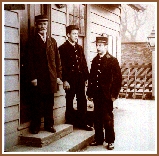
The photo on the left is from a
glass plate in the Rev Coleman
Collection. Mr Rodmell, the
Station Master, seen here
sporting a fine Edwardian beard,
with two of his staff, an
unknown lad, centre, and Mr
White.
 Some
more likely Hull lads here,
though some may be from Sutton.
I wonder if anyone recognises
any of these fine young
reprobates . . Click the picture
for a closer look. Are they Hull
Sea Scouts, Sea Rangers . . ?
Previous offences will be taken
into consideration !!
Some
more likely Hull lads here,
though some may be from Sutton.
I wonder if anyone recognises
any of these fine young
reprobates . . Click the picture
for a closer look. Are they Hull
Sea Scouts, Sea Rangers . . ?
Previous offences will be taken
into consideration !!
I suspect someone will see their
dad or grandad in here.
Use
this page also in conjunction
with the Family History
information and links page for
more information as to what is
in the Centre, and other links
on the World Wide Web.
![]()










